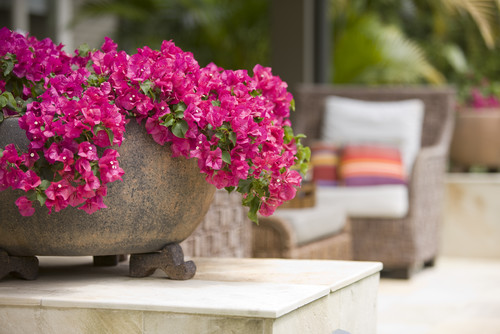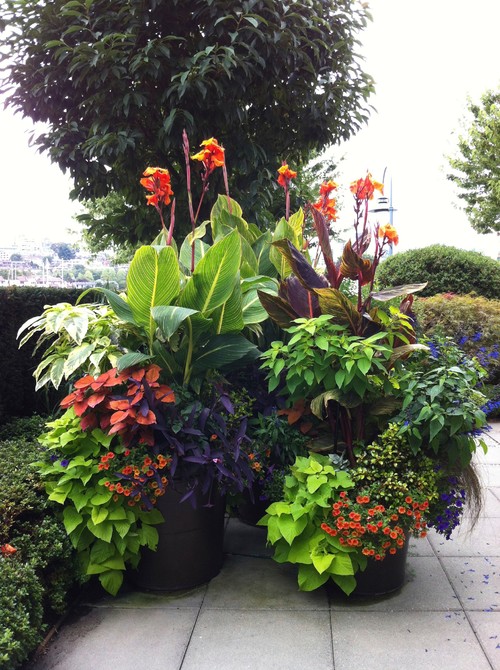10 sizzling-hot summer containers

By Lauren Dunec Hoang
Turn up the heat with these bright, bold container compositions that feature red, orange, chartreuse, vivid pink and deep purple hues. You may not want your whole garden to be filled with these super-saturated colors, but why not give a few containers a try? Here are 10 standout container designs to get you started.
1. Just one plant. One of the simplest tricks when it comes to containers is limiting the design to one plant (or plant variety) per pot. Here, a single dwarf bougainvillea (USDA zones 9 to 11; find your zone) in vibrant magenta packs a lot of punch, spilling out in pink cascades over a ceramic bowl. Unlike the full-size sprawling vines, dwarf bougainvillea reaches only 2 to 3 feet tall and 1½ to 2 feet wide, making it a perfect container-size specimen.
Water requirement: Moderate; lower once established
Light requirement: Full sun
2. Tropical beauty. This stunning trio gives a patio in Vancouver, British Columbia, a feeling of the tropics with lush, colorful foliage, hot-colored flowers, cascading vines and an overall jungle-like exuberance.
Planted roughly from back to front are orange-flowering canna lily, brugmansia, ‘Sedona’ coleus (Solenostemon scutellarioides ‘Sedona’), blue-flowering anise-scented sage (Salvia guaranitica ‘Black and Blue’), small-leaved ‘Tequila Sunrise’ mirror plant (Coprosma ‘Tequila Sunrise’), trailing lime-green sweet potato vine (Ipomea batatas), purple heart (Tradescantia pallida ‘Purpurea’) and orange-flowering million bells (Calibrachoa sp.).
To keep the plants looking lush, Glenna Partridge, the designer of this plant-packed trio, recommends fertilizing every week to 10 days with water-soluble fertilizer.
In cold-winter climates, treat tender subtropicals such as canna lily and coleus as annuals (pulling them after a season), or overwinter plants inside a heated greenhouse or on a windowsill indoors.
Water requirement: Regular (keep soil moist)
3. Sunset glow. With hues as rich and vibrant as a sunset sky, this summer container lights up a Chicago backyard. Pink and magenta shades are chameleon-like in hot-colored container combinations, appearing bright if used with greens and purples or having more cooling effects when paired with reds and oranges.
Here, the magenta petunia cools the otherwise fiery combination of coral tiplant (Cordyline fruticosa, Zone 11) foliage, medium-pink gaura (Gaura lindheimeri, Zone 5), orange-flowering lantana (Lantana camara, zones 9 to 11) and Big Red Bronze Leaf begonia.
Water requirement: Regular (keep soil moist)
Light requirement: Full sun to partial sun
4. Orange and purple. Take advantage of the pleasing balance of complementary colors by pairing hues that sit opposite each other on the color wheel. For example, golden-orange lantana (Lantana camara, zones 9 to 11) trained into standards paired with low-growing purple-blue fan flower (Scaevola aemula, zones 10 to 11) makes a simple yet stunning combination. Get a similar effect using foliage rather than flowers for color by pairing a gold-leaved coleus, such as Solenostemon scutellarioides ‘Copper Glow’, with trailing purple heart (Tradescantia pallida ‘Purpurea’, zones 10 to 11).
Water requirement: Moderate
Light requirement: Full sun
5. Pretty in pink. A sweet combination of pink bedding dahlias, zinnias and peach lantana forms a cheerful, monochromatic container display on a Minneapolis patio.
Dahlias come in two types: tall varieties grown from tubers that reach 3 to 5 feet, and short (under 1½ feet) bedding types often grown from seed. The bedding types are perfect for smaller containers as colorful, midlevel fillers and don’t need any staking to keep them upright. Taller varieties require staking and are best planted at the back of larger pots with medium-height flowers tucked around the base of the stems.
Water requirement: Moderate
Light requirement: Full sun
6. Low water. For a dramatic container display that can take summer heat without needing frequent irrigation, take a look at this planting trio in San Luis Obispo, California. The designer used a simple trio of a large-scale agave, a low-growing filler of blue chalk sticks (Senecio mandraliscae, zones 9 to 12), and orange-flowering parrot’s beak (Lotus maculatus, zones 9 to 11) for a hit of color.
This drought-tolerant “recipe” could easily be reproduced with plants with similar attributes. For example, one could choose a focal-point succulent like an aeonium, a low-growing filler such as stonecrop (Sedum spp.) and a bright accent such as hot-orange blanketflower (Gaillardia spp.) or lime-green ‘Angelina’ stonecrop (S. rupestre ‘Angelina’, zones 3 to 11).
Water requirement: Low once established
Light requirement: Full sun to partial sun
7. Shady pair. Brighten up a gloomy corner with a combination of shade-loving plants with light-colored blooms or foliage. This partly shaded pair of pots in Chicago includes pink-blooming begonias and fuchsias trained into standards as well as bright cascades of ‘Silver Falls’ dichondra (Dichondra argentea ‘Silver Falls’, zones 9 to 11) and golden creeping Jenny (Lysimachia nummularia ‘Aurea’, zones 3 to 9).
Water requirement: Moderate to regular (soil dries out more slowly in shade but should be kept moist)
Light requirement: Partial shade to full shade
8. Hot salsa. As zesty as a dose of chili and lime, this spicy combination heats up an urban terrace in a high-rise in Vancouver, British Columbia. At the back of the container, a strappy ‘Apricot Queen’ New Zealand flax (Phormium ‘Apricot Queen’, zones 8 to 11) adds height and structural interest. Orange-flowering trailing begonias and chartreuse sweet potato vines (Ipomea batatas, zones 9 to 11) alternate in bright spills over the sides of the container.
Water requirement: Moderate
Light requirement: Full sun to partial sun
9. Bright window box. Window boxes filled with hot-colored summer blooms can enliven your front yard. In this vivid London entry, ruby-red million bells (Calibrachoa sp.) spill over the edge below the slender stems of purple-flowering purpletop vervain (Verbena bonariensis, zones 7 to 10), silvery rose campion (Lychnis coronaria) and rosemary (Rosmarinus officinalis, zones 8 to 11).
Window boxes dry out quickly due to the relatively small amount of soil. It’s best to set up a drip-irrigation system to deliver frequent small amounts of water. The purpletop vervain, rose campion and rosemary all thrive in lightly moist to slightly dry soil, so it’s best not to allow the window box to get soggy.
Water requirement: Regular small amounts
Light requirement: Full sun
10. All foliage. Well, almost all foliage. This potted combination in Atlanta relies primarily on leaf color, rather than blooms, for a long-lasting combination that requires less care than needed for flowers. From top to bottom, we see speckled pink-and-green elephant ears (Caladium sp.), purple-leaved tradescantia (Tradescantia sp.) and lime-green sweet potato vine (Ipomea batatas, zones 9 to 11). There’s so much interest and contrast among the foliage plants that one hardly notices the more subtle red flowers of a trailing begonia and pink impatiens at the back left.
Water requirement: Regular (keep soil moist)
Light requirement: Partial shade or bright, indirect light
Original source: Houzz
Read original article here.
Original article: The Province
Read original aricle here.










